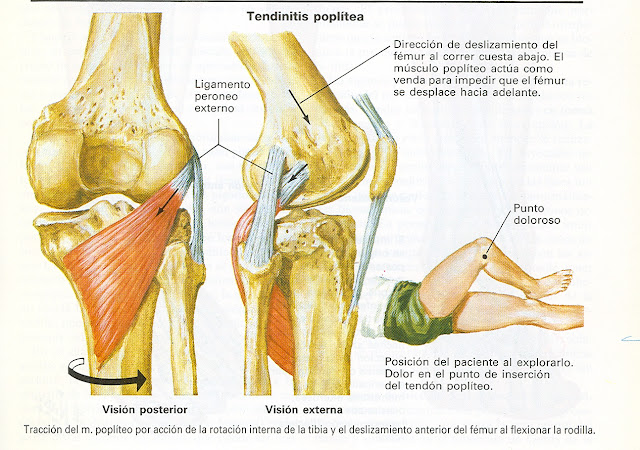In general, the popliteus muscle is a bit concerned. At the risk of considering too much, we will expose what is believed about him.
Probably the knee is one of those muscles on which we have no clear function.
The popliteal muscle is a short, flat and with a large number of receptors, like many stabilizers, (I can not see the analogy to the shape and orientation with the scapular-humeral muscles) that runs along the back of the knee.
Perhaps in physiotherapy, when we think about the location of the pain from the knee, think of the area of \u200b\u200breferred pain of the knee in the back.
And we remember less pain on the outside of the knee tendon.
The function of the knee is quite controversial. Possibly the most classic is to consider knee flexor and internal rotator tibia.
Studies report the section of the popliteal tendon causes an increase in external rotation and lateral displacement of the tibia, thus should be considered, on that basis that its main functions are internal rotator and stabilizer of the knee varus.
In fact, it's the knee flexor, is rebutted by saying that acts as an extender.
As for his role as a stabilizer, There is more to add to the prevention of varus.
not only limits the varus, with collateral ligament and biceps femoris CIT, also limits the forward slip of the femur (posterior tibial or, if you will say so ), running on slopes downward, helping the PCL (posterior cruciate). also controls external tibial rotation eccentric. proprioceptive has a very important role to swing or make quick changes of direction which also involve rotation. As a stabilizer muscle is proactively contracts on the movement of the knee, especially when it is flexed.
The knee, along with the ligaments of Humphrey and Wrisberg prevent injury to the lateral meniscus . The previous slide slows knee during flexion. Although we have seen that the insertion of the popliteus at the meniscus is an anatomical variable, absent in a considerable percentage.
For the medial distal popliteal some fibers are connected with the fascia that inserts into the medial collateral ligament. On the side, in addition to the femoral condyle, fibular head and posterior horn of the lateral meniscus, the knee has inserts also be inconsistent, in the oblique popliteal ligament and arcuate ligament of Wrisberg and Humphrey and posterior cruciate ligament.
popliteal-fibular ligament strained knee muscle when activated in its role of stabilizer. With the knee flexed knee-fibular ligament is stretched, and compensates for the lack of stability created by relaxation of the collateral ligament, joint capsule and ligaments.
The function of the knee is one of the most investigated. This table shows 25 studies, which considered the role of the knee:
In 12/25, Protector of the lateral meniscus with the knee flexed (keeps it later)
In 12/25, external rotation of the femur with the tibia fixed.
In 11/25, internal rotation of the tibia.
In 11/25, Control of postero-external stability. Resists posterior tibial load.
In 3 / 25, consider that operates in load.
In 3 / 25, limits the forward slip of the femur on the tibia with the knee flexed. (Drawer back)
In 2 / 25, Active during the swing phase just before heel strike and for two thirds of the stance phase.
In 2 / 25, limits hyperextension.
In 1 / 25, keeps standing balance
In 1 / 25, Help the lateral collateral ligament maximum deflection
In 1 / 25, anterior subluxation Increases postero-external instability
In 1 / 25, knee extensor
U ne of the most important clinical entities in which there be considered when the knee is postero-lateral instability, which devote input.
I think it would be prudent to consider the knee, but not overestimate its frequency. A study of 2412 knees knee injury found by MRI, only 24 of them and of those 24 only 2 were exclusively a knee injury. What is extracted is not very common to find a knee injury, at least radiologically visible. This represents only 1% of injured knees.
Here you have an interesting link:





